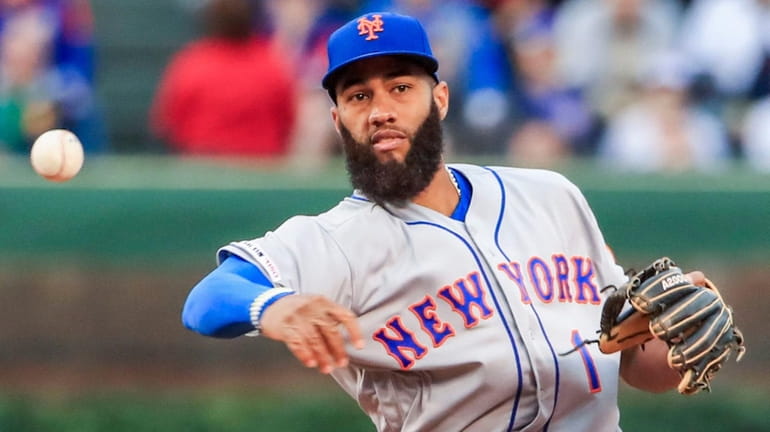How Juan Lagares' position change to centerfield sets a precedent for Amed Rosario

Mets shortstop Amed Rosario throws out Cubs leftfielder Kyle Schwarber on a ground ball in the first inning at Wrigley Field in Chicago on June 20. Credit: EPA-EFE/Shutterstock/Tannen Maury
As the Mets ponder putting Amed Rosario in centerfield, an experiment that remains in the early stages and is at least weeks away from becoming a major-league reality, it’s worth remembering: His outfield mentor, quality control coach Luis Rojas, has done this before.
A decade ago, beginning at the Mets’ academy in the Dominican Republic and later in a coastal Georgia city, Rojas was a lower-level minor-league coach tasked with helping a supremely athletic but young and raw shortstop learn the outfield. A few years later, Juan Lagares was a Gold Glover.
“In less than a year, you could see how the transition really fell into place, for him to be a great defender out there,” said Rojas, who is in his 13th season in the Mets' organization and his first on the big-league staff. “All those tools, bringing them to the outfield, making the transition easy. That’s pretty unbelievable.”
Lagares was 19 and a lifetime infielder in the fall of 2008, when Omar Minaya’s front office decided he would spend his time in the instructional league learning a position that was foreign to him beyond goofing around during batting practice.
Not a particularly good shortstop, Lagares the next spring was headed back to the Savannah Sand Gnats, then the Mets’ low Class A affiliate, where he was going to get bumped by a shortstop prospect named Wilmer Flores. A move to the outfield was a way to give Lagares’ stalling, injury-filled career new hope.
Turns out, he was a natural at his unnatural position.
“I remember, I always liked to shag [fly balls during BP],” Lagares recalled Sunday morning in San Francisco. “Even when I wasn’t an outfielder, I liked to go to the outfield and run after balls, you know? [Rojas] always told me, ‘I think you got good ability to be an outfielder.’ I was an infielder, but I could run a lot. He always hit me fungoes, line drives, that kind of stuff. He told me, ‘I think you’re gonna be good. Keep working and keep doing what you do.’ ”
Rojas added: “From the first impression, he was pretty impressive — how easy he clicked into the movements in the outfield, basic things like routes, reads off the bat, how easy it was to transition from the infield.”
Still, Lagares didn’t find an immediate home in centerfield specifically. He played mostly left and right for that 2009 Savannah team, with center manned by, among others, Rafael Fernandez (who has since made his own climb up the coaching ranks, serving as a coaching assistant for the big-league club this year).
In 2010, when Lagares started in Savannah for a fourth year in a row and Rojas was promoted to that club’s coaching staff, they reunited and their outfield work eventually centered around center.
“He didn’t play center every day, but the times he was in center, it was delightful,” Rojas said. “Next thing you know, we were talking about him probably being our best centerfielder in the organization.”
Lagares rose steadily from there, debuting in the majors in 2013, winning the National League Gold Glove in center in 2014 and signing a $23 million contract extension in 2015. That deal ends after this year, and unless the Mets pick up his $9.5 million option for 2020, which is highly unlikely, he will be a free agent this winter. Lagares’ bat never developed the way the Mets thought it might, and he remains a below-average hitter.
Rojas sees some similarities between Lagares then and Rosario now. Like Lagares, Rosario has long been fond of chasing pop flies during BP. Lagares said the toughest part of the transition is reading batted balls, which is “hard” and “completely different” from doing so in the infield. The all-around athleticism, though, helps.
“You could see that [comparison] as far as athleticism,” Rojas said. “Rosario is a tick faster, but if at one point the decision is made when he’s fully going to go there, we’ll probably have a better answer for that.”
Rosario’s instruction in center has been the beginning of the basics — reads during batting practice, learning his way around the warning track and the wall — and the Mets aren’t even sure if he’ll play there in a game this season. It’s too soon to know if Rosario will take to the outfield like Lagares did, but Lagares can imagine it working.
“He could be really good,” Lagares said. “He can move really well. If you play in the middle of the field, you play shortstop, I think you can play anywhere.”
